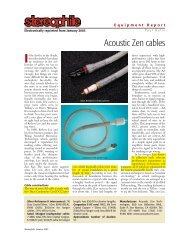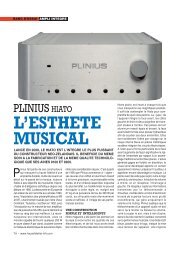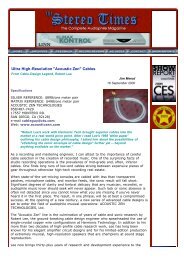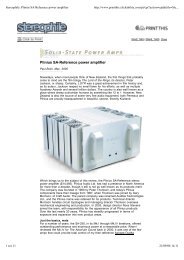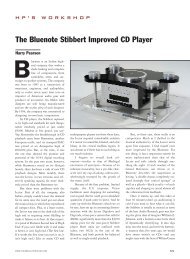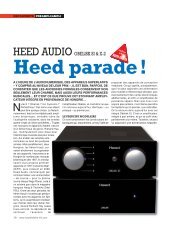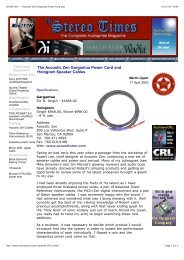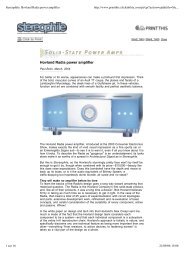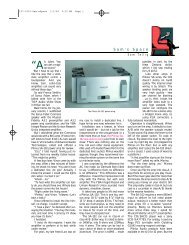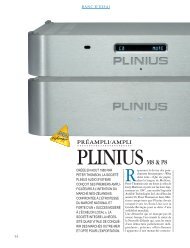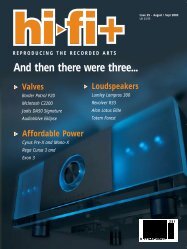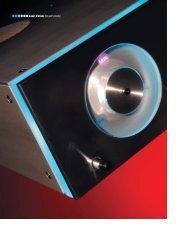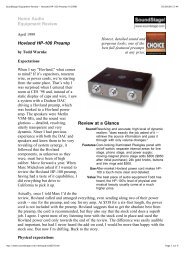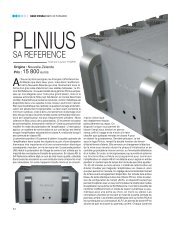Hovland HP-200 Vacuum Tube Preamplifier - Jason Diffusion
Hovland HP-200 Vacuum Tube Preamplifier - Jason Diffusion
Hovland HP-200 Vacuum Tube Preamplifier - Jason Diffusion
You also want an ePaper? Increase the reach of your titles
YUMPU automatically turns print PDFs into web optimized ePapers that Google loves.
cover story<strong>Hovland</strong> <strong>HP</strong>-<strong>200</strong> <strong>Vacuum</strong><strong>Tube</strong> <strong>Preamplifier</strong>Consistently elegant, detailed, and naturalWayne GarciaIn last issue’s CES report, Idescribed the sound in the<strong>Hovland</strong> Company’s room at theAlexis Park Hotel as “consistentlyelegant, detailed, and natural.”That listening experience dovetailedalmost precisely with the installation inmy system of <strong>Hovland</strong>’s <strong>HP</strong>-<strong>200</strong> tubepreamp, RADIA solid-state amplifier,and matching cable set. Having nowlived with the <strong>Hovland</strong> gear in my systemfor the past few months, I stillthink those three words neatly summarizethe <strong>Hovland</strong> sound. But I wouldadd another (if overused) word to myoriginal list: musical. Or to put it moreprecisely, the longer I live with thisequipment the more it seems that the<strong>Hovland</strong> sound is not simply musical—as in seductive, flowing, involving—but at the service of the music. Yes, it isdetailed, but doesn’t wow you in that “INot only did the <strong>Hovland</strong>Company take an unusuallylong time to gestate, but eachcomponent undergoes asimilarly lengthy growth periodnever heard it like that before” sort ofway, but rather in a way that reveals theinner workings of a performance. Yes, itis elegant, but not in the way some componentsare, i.e., overly polite or controlled-sounding.The <strong>Hovland</strong> sound iselegant in its ability to effortlessly connectmusical dots and lines into an interconnectedwhole. And yes, it is natural,in that it allows instrumental and vocaltimbres and textures to sound likethemselves, but more importantly (tome, at least), in a way that brings thehuman element out of a recording—howa singer’s breath phrases a line, a guitarist’stouch adds meaning to a chordpattern or lead, or a violinist’s techniqueconveys the emotion in a score.To many of us, <strong>Hovland</strong> is knownprimarily as the company that for yearsmade the outstanding and aptly namedMusiCap, 1 and more recently as themaker of its own line of criticallyacclaimed components. But the company’scurrent team—Michael Garges,head of production; Jeffrey Tonkin, CEOand chief industrial and mechanicaldesigner; and Alex Crespi, head of salesand marketing—have been friends,long-time audiophiles, serious musiclovers, and tireless tinkerersfor more than 20 years.Over the course of time,they, along with partnerRobert <strong>Hovland</strong>, whoremains on the board but isno longer involved in thecompany’s day-to-day operations,also developed theirown cables, custom speakers,and electronics, incorporating as the<strong>Hovland</strong> Company in 1999.In a recent interview with the trio, itbecame apparent to me that not only didthe <strong>Hovland</strong> Company take an unusuallylong time to gestate, but that each individualcomponent underwent a similarlylengthy period from inception to birth.“We’re able to design and release just onemajor new component a year,” Crespitold me. “One of the plusses of havingworked together for so long is that wehear and almost always agree on each ofthe hundreds of little decisions that gointo a final design. We only want to1 A polypropylene film and conductive foil capacitor currently used by a couple hundred high-end manufacturers.54 THE ABSOLUTE SOUND ■ JUNE/JULY <strong>200</strong>6
cover storyand layout man Jeffrey Tonkin is also anarchitect. “When it comes to puttingtogether a product,” Tonkin said, “eachis a complete whole, built from blocks.Everything is done in support of thebasic circuitry, from the proximity of allinternal parts to the circuit layout.”Since one of the few complaints aboutthe <strong>HP</strong>-100 was its lack of remote control,from the start <strong>Hovland</strong> conceivedthe <strong>HP</strong>-<strong>200</strong> as remote-controllable. Butthat, as the saying goes, was easier saidthan done. The absence of a remote controlon the <strong>HP</strong>-100 didn’t reflect someretro-thinking on the designers’ part,but rather this group’s dedication toconsidering all aspects of a product aspart of its reason for being. Not happywith the sonic degradation of potentiometers,<strong>Hovland</strong> developed its ownhandmade, silver-contact, 31-step discrete-resistorvolume control—a decidedlyremote-unfriendly device. For usein the <strong>HP</strong>-<strong>200</strong>, this pricey item morphedinto an attenuator circuit of highlylinear metal-film resistors with twinrelays that have been rhodium-platedand hermetically sealed in glass.Connect all of this to a tiny, isolatedlogic board, et voilà, you get a sonicallyuncompromised remote volume control.A similar remote-relay-process performsinput selection and other functions.And because these controls sitdirectly next to the rear-panel jacks,they’re out of the signal path, and ofcourse circuit paths have been made thatmuch shorter. Although the <strong>HP</strong>-100and <strong>HP</strong>-<strong>200</strong> share the same three-tubelinestage and solid-state power supply,these improvements are said by thosewho know both units—I have not hadthe chance to compare them—to bringgreater degrees of detail and transparencyto the sound of the <strong>HP</strong>-<strong>200</strong>.By the way, a peek under the hoodreveals a dedication to perfection as highas any I’ve seen—this unit is beautifullymade. Aside from metal machining andplating, all work is performed at<strong>Hovland</strong>’s L.A. facility, where a staff of12 hand-assembles each unit.A pretty definitive example of howthe <strong>Hovland</strong> gear serves the musicInstrumental timbres are too-die-for-beautiful,yet never overly thick or romanticizedarrived during one of my first listeningsessions with it. The Stern/Bernsteinreading of the Barber Violin Concerto[Sony CD] is one I know very well, notonly from my own time with this gorgeouspiece of music but also because itis one of the discs my colleague Johannesder Valin regularly carries to CES. In tandemwith Kharma’s outstanding 3.2 andMini-Exquisite speakers and MBL’sequally outstanding 1521a transport and1511e DAC, the <strong>Hovland</strong> systembrought this excellent “Golden Age”-eraanalog recording to vivid life, projectingan unusually deep and expansive soundstage,with notable cushions of airaround the players. Instrumental timbres—woodwinds,brass choirs, massedstrings, both bowed and plucked—aretoo-die-for-beautiful, yet never overlythick or romanticized. During lightlyscored passages, one senses, say, a violinor flute projecting over the orchestra andco-mingling in space in a way that’shighly reminiscent of the concert hall.And Stern’s magnificent Guarnerius delGesù, so beautifully captured here, is allaged-wood and rosin in the middle reg-56 THE ABSOLUTE SOUND ■ JUNE/JULY <strong>200</strong>6
cover storyisters, sweet yet steely and ultra-extendedup top (especially over the KharmaMini, with its knock-’em-dead diamondtweeter). The dynamic range runssmoothly from whisper-delicate to fullbloom. Through the <strong>HP</strong>-<strong>200</strong> andRADIA, the disc was easy and naturalsounding if not, ultimately, as explosivelydynamic as it is when heard throughsomething like the MBL 5011 linestageand Kharma MP-150 monoblock amps,which came in towards the end of mysessions with the <strong>Hovland</strong>. Nor were the<strong>Hovland</strong>’s tone colors quite as rich asthey are with this combo, but that lightnessof touch is part of the <strong>Hovland</strong>’sunderstated beauty.Turning to the visceral soul-funk ofOutkast’s “Love Hater,” fromSpeakerboxxx/The Love Below [Arista], the<strong>Hovland</strong> designs proved fully capable ofmoving some serious air. The tune’sthrobbing electric bass reached way downand could be felt in the gut; horn accentspopped; and a wailing wah-wah-soakedguitar cut through the mix while retainingexquisite clarity and composure, asdid André 3000’s falsetto vocal. Good asthe bass is, though, it didn’t quite havethe grip or definition the <strong>Hovland</strong> displaysin the rest of the frequency spectrum,and was also just a tad soft and lightwhen compared to the MBL/Kharma duo.The RADIA AmplifierDelivering 125Wpc into 8 ohms and <strong>200</strong>Wpcinto 4 ohms, the solid-state RADIA is a truedual-mono design, with each channel sharingonly a common AC cord. Like other <strong>Hovland</strong>components, the amp represents the designteam’s 25-year exploration of parts, wire, and circuit topologies.The amplifier uses a complementary symmetrical driver/outputtransistor designed for low distortion, and highimpedanceJ-FET input circuitry that does away with the needfor DC offset controls. For rigidity, the chassis is dampedand utilizes monococque construction, and like all <strong>Hovland</strong>’scomponents the RADIA is fitted with the company’sMusiCaps and is internally wired with <strong>Hovland</strong>’s Generation3 interconnect.Sonically, the RADIA is much like the <strong>HP</strong>-<strong>200</strong>. It revealsdetail in the music without ever sounding analytical. What Iwrote about the preamp applies to the amplifier, too. Thatsaid, I don’t think the RADIA attains quite the same level ofperformance as the <strong>HP</strong>-<strong>200</strong>. Oh, it’s good, very good. But toget a better gauge of how the units perform separately,toward the end of my time with the <strong>Hovland</strong> gear I replacedthe RADIA with Kharma’s MP-150 mono amps. Some of thebottom-end reticence vanished, revealing a better sense ofgrip and detail in the bass. The RADIA is likewise not astransparent as the <strong>HP</strong>-<strong>200</strong>, nor as airy. These gaps are notwide, but I do believe it shows that <strong>Hovland</strong>’s design team isbringing greater levels of performance to its gear with eachnew step.WG58 THE ABSOLUTE SOUND ■ JUNE/JULY <strong>200</strong>6
cover storyTurning my focus to LP playback,the P-<strong>200</strong> phonostage started off as astandalone phono preamp that wouldoffer multiple inputs and options. But asthe design developed and manufacturingcosts were weighed, <strong>Hovland</strong> realized itwas looking at a $5000–$6000 component.While that is hardly ultra-expensivein today’s market, the <strong>Hovland</strong> teamdetermined that, along with the inherentsonic advantages of a single box, its customerswould reap a far higher value byplacing the P-<strong>200</strong> directly inside the<strong>HP</strong>-<strong>200</strong>. A solid-state design, the P-<strong>200</strong>is located at the rear-left of the chassis,with its dedicated power supply restingat the far right in the same bay that housesthe linestage’s power supply. The P-Turning to the visceral soul-funk of Outkast’s“Love Hater,” the <strong>Hovland</strong> designs proved fullycapable of moving some serious air<strong>200</strong> is compatible with virtually any cartridgewhose output is 3mV or less. Toadjust gain and impedance (see spec boxfor ranges), simply remove six hex screwsfrom the left side plate to reveal tworecessed screws. Match the screw slot tothe printed legend, replace the plate, andyou’re done.Alex Crespi told me that the companywanted the P-<strong>200</strong> to stand upagainst the best. And though some ofthe best I’ve heard are no longer inhouse(specifically the Manley Steelheadand Sutherland’s Ph.D.), I do have onhand the excellent Artemis Labs PL-1that I raved about back in Issue 155.Though priced at $3150, the Artemisholds its own against the stellarSteelhead ($7300), so I know it’s amongthe finest out there.The comparison was highly instructive,and didn’t prove <strong>Hovland</strong>’s claimsabout the P-<strong>200</strong> to be at all off themark. Not surprisingly, like the <strong>HP</strong>-<strong>200</strong>linestage, the P-<strong>200</strong> is an extremelyclean and graceful performer. Listeningto another favorite, Wilco’s Yankee HotelFoxtrot [Nonesuch/Sundazed LP], singerJeff Tweedy’s voice was easy, uncolored,and focused. Moreover, it lacked the“shouty,” slightly hooded quality one60 THE ABSOLUTE SOUND ■ JUNE/JULY <strong>200</strong>6
sometimes hears on certain tracks,specifically “Jesus, Etc.” The Artemisnoticeably softened the presentation,and sounded slightly less focused.Though Tweedy’s voice was warmer onthe Artemis (it’s a tube unit), and wasmore richly textured with a bit more airsurrounding it, it did exhibit a hint ofthat “shout.” On the White Stripes’Zeppelinesque shake-up of BurtBacharach’s “I Just Don’t Know WhatTo Do With Myself,” the <strong>Hovland</strong> waslighter and brighter (but not “bright,”in the negative sense of the word) withplenty of air, terrific detail, and powerfulpunch on Meg White’s kick drum. TheArtemis was richer, slightly more explosivedynamically, but not as defined.Finally, on the classic Vienna 1908-1914[Mercury/Speakers’ Corner LP], theArtemis had a darker overall presenta-WWW.THEABSOLUTESOUND.COM 61
cover storytion, with a sweeter string tone, excellentdynamic shading, and a lovelyimpression of depth. Though the P-<strong>200</strong>’s soundstage may not have beenquite as deep or tall as that of theArtemis, it was more extended and airyup top, not as dark, more tightlyfocused, with equally good dynamicshading, plenty of transient snap, andtransparent in the sense of “seeing into”SPECIFICATIONS<strong>HP</strong>-<strong>200</strong> vacuum tube preamplifier<strong>Tube</strong> complement: Two 12AX7, one12AT7Inputs: CD plus four line-level stereopairs (three if ordered with optionalphonostage), bypass (for theaterprocessor), and tape, all via RCA connectorsOutputs: Balanced via XLR connectors,unbalanced via RCA connectorsDimensions: 18.25" x 4.88" x 15.52"Weight: 27 lbs.P-<strong>200</strong> solid-state phonostage (optional)Input impedance: Five selectable (100kohms maximum, 47k, 390k, 100k, and24 ohms)Gain: Selectable in 3dB steps from 57dBto 69dBRADIA solid-state power amplifierPower output: 125Wpc @ 8ohms;<strong>200</strong>Wpc @ 4ohmsDimensions: 18.25" x 7.20" x 16.65"Weight: 74 lbs.ASSOCIATED EQUIPMENTRedpoint Model B turntable; Tri-Planar VIIarm; Shelter 90X cartridge; MBL 1521atransport, 1511e DAC, and 5011 preamp;Artemis Labs LA-1 linestage and PL-1 phonostage; Kharma MP-150monoblock amps; Kharma Ceramique 3.2and Mini Exquisite speakers; Kubala-Sosna Emotion interconnects, speakercables, power cords, and Expression digitalcable; Tara Labs Zero digital cable andThe One power cord; Nordost Thor powerdistribution center; Finite ElementeSpider equipment racks; Hannl Merarecord cleaning machine, L’Art du Son LPand CD cleaning fluids<strong>Hovland</strong> CablesAside from the relativelywell-known Music Groove2 arm cable (my Tri-Planar can’t accommodateit, but I’m hoping tohear it soon with the GrahamPhantom), <strong>Hovland</strong>’s cable designs areone of the company’s better-keptsecrets. And given what premiumcables can run these days, they’re alsoalmost ridiculously low in cost (seeManufacturer’s Information box fordetails). <strong>Hovland</strong>’s Generation 3 interconnectis made of fine strands ofhigh-purity silver-plated copper thathave been configured in a star-quadarrangement and sheathed in a braidedshield. Four bundles of thesestrands are found in each channel,the recording. Like the best of the highend,both were excellent and presentedtheir own take on the music.As a relative newcomer to the<strong>Hovland</strong> party—this is my first reviewof its gear—I am mighty impressed bywhat these guys are doing. They have aclear vision of how music sounds, arehighly dedicated to offering productsthat truly add something to the market,never tire of rethinking established formulas,and most importantly buildhighly musical components of very goodvalue. And just think, after 20 yearsthey’re just getting started. &individually Teflon-insulated and pairedtogether into two positive and two negativeconductors. The shielding andjacket reduce RFI and electromagneticinterference, and both balanced XLRand single-ended RCA connectors areavailable. The Reference speakercable employs a similar silver-platedcopper wire treatment, with each channelcomprising four thick bundles thatare twisted together and wrapped inseveral constraining layers, a braidedshield, and additional layers of jacketing.The Nine-Line speaker cable issaid to offer 90% of the Reference’sperformance for half the cost. Finally,the Main Line is a polarized, fullyshielded AC cable built from high-purity,silver-plated copper stranding andformed into a cross-layered configuration.According to <strong>Hovland</strong>, the MainLine maintains a circuit’s maximumelectromagnetic energy.Except for the Nine-Line, I used allof <strong>Hovland</strong>’s cables throughout myaudition period and found them to befast, rich in tone color, and of fine overallbalance and detail. I also tried themwith the MBL and Kharma electronicswith terrific results. Compared directlywith the Nordost Valkyrja cables thathave been my reference, the <strong>Hovland</strong> isa little warmer, not quite as detailed,yet richer and weightier on the bottomend, and a tad less extended on top. Ifyou purchase <strong>Hovland</strong> gear, the cablesare something of a no-brainer, especiallyconsidering their value.WGMANUFACTURER INFORMATIONHOVLAND COMPANY1545-A Pontius AvenueLos Angeles, California 90025(209) 966-4377hovlandcompany.comPrices: <strong>HP</strong>-<strong>200</strong> preamplifier, $7500(add $<strong>200</strong>0 for P-<strong>200</strong> phonostage);RADIA amplifier, $9500; Generation 3interconnects, $380 per 1 meter pair;Reference speaker cables, $1295 per8-foot pair; Main Line power cables,$400 per 6-foot length62 THE ABSOLUTE SOUND ■ JUNE/JULY <strong>200</strong>6



